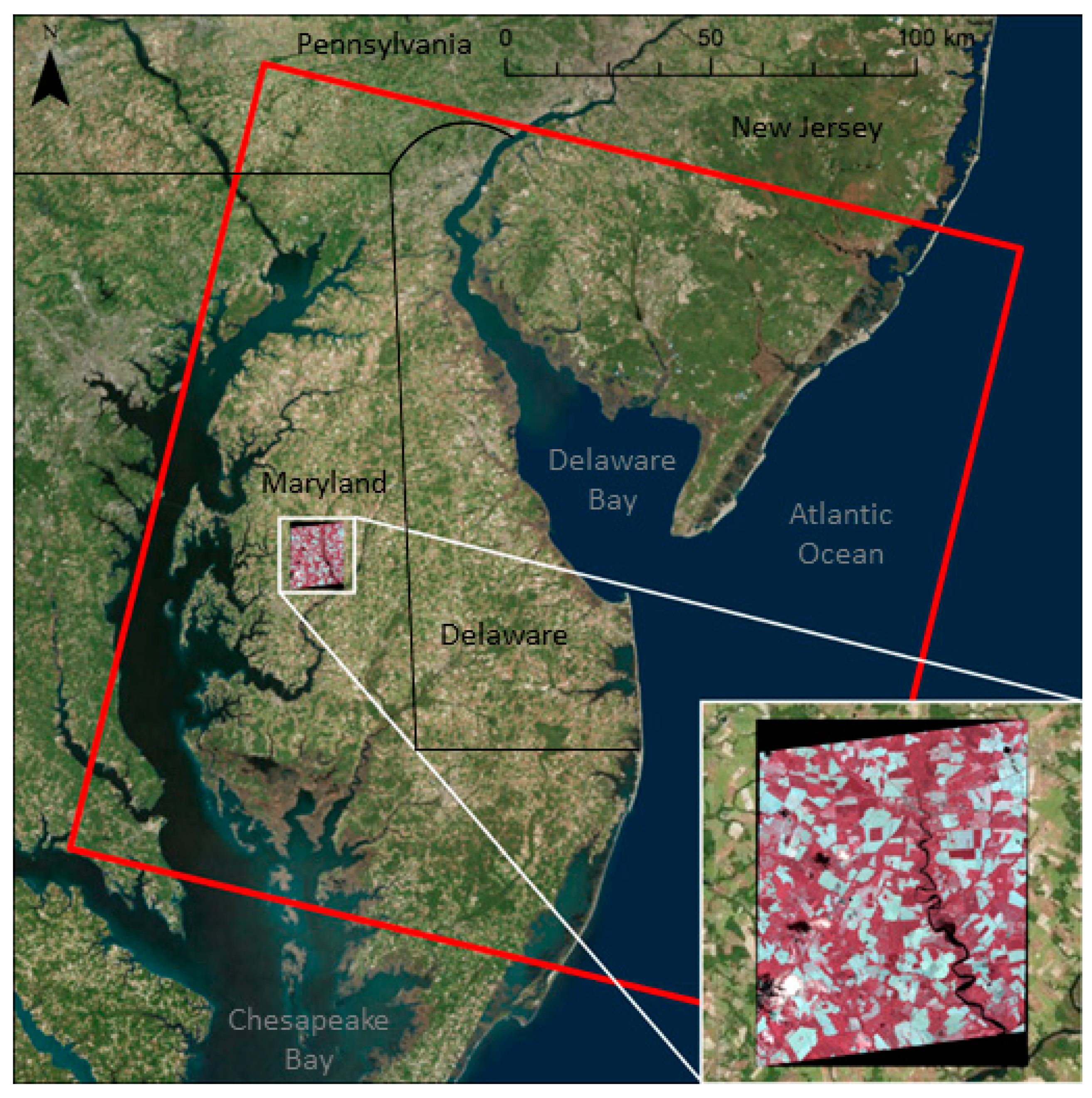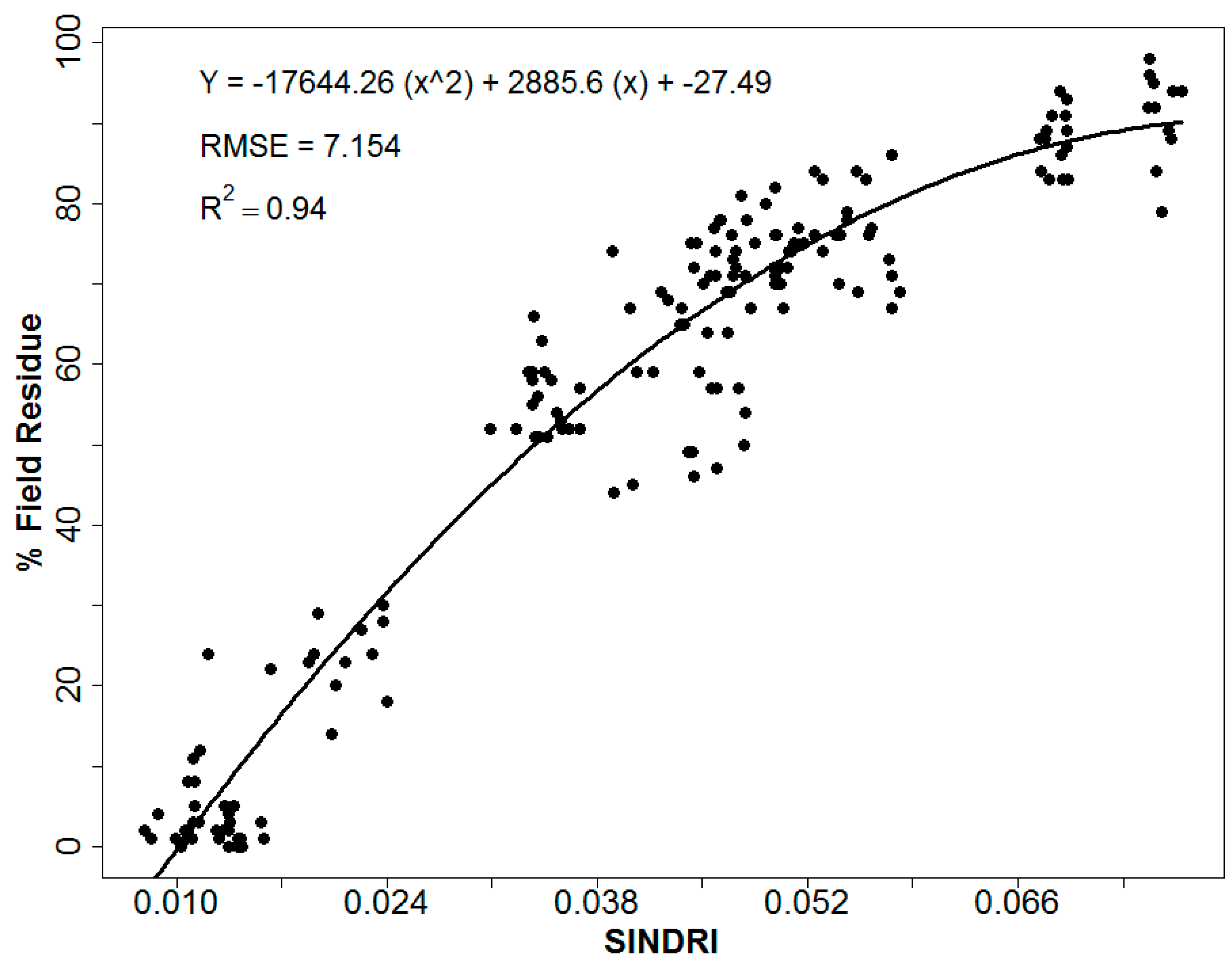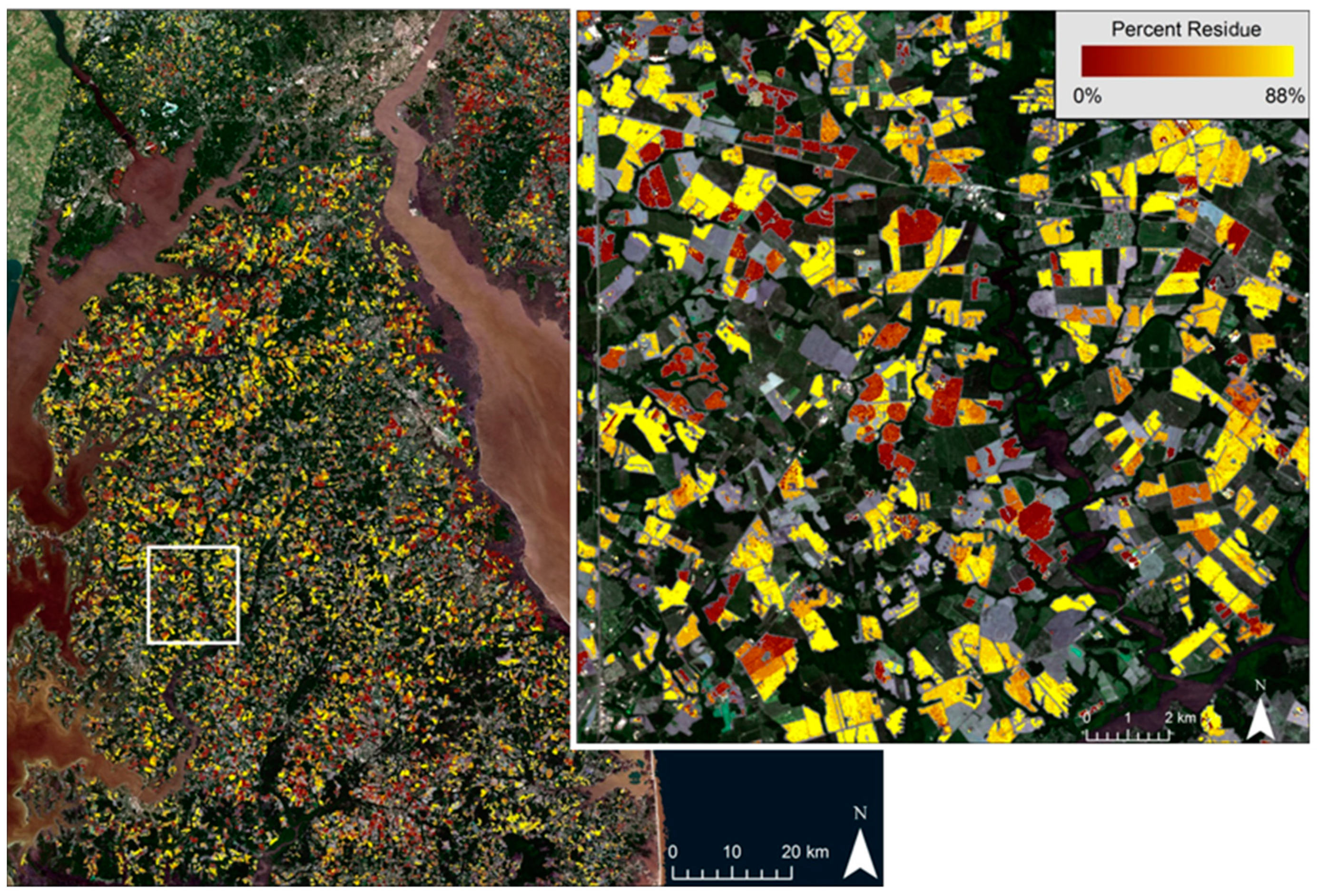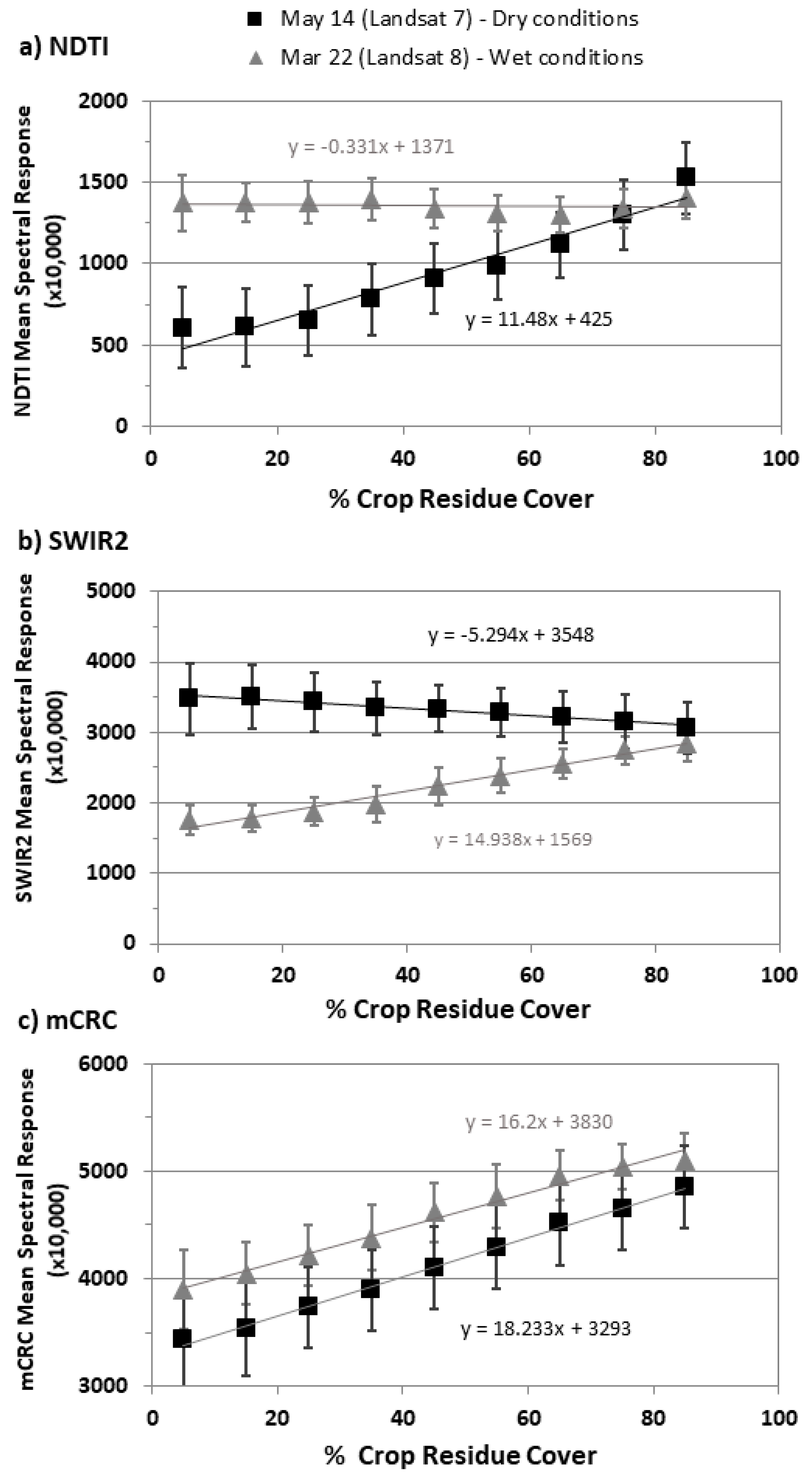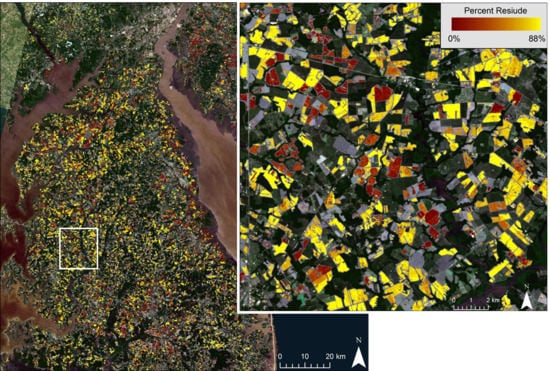1. Introduction
Conservation tillage, which can be defined as any form of tillage that minimizes tillage intensity and maintains crop residue on the soil surface, is a best management practice with well-documented benefits to agricultural ecosystems. Some of these benefits include reduced runoff and soil erosion, increased infiltration and aggregate stability, greater soil carbon accumulation, enhanced soil health, and improved water quality in neighboring water bodies [
1,
2,
3]. The use of conservation tillage has been incentivized throughout the United States by the U.S. Department of Agriculture Natural Resources Conservation Service, and the practice is often adopted to meet conservation requirements for highly erodible lands [
4]. In the Chesapeake Bay watershed, where reductions in agricultural runoff and erosion can have substantial benefits to the health of the Chesapeake Bay estuary [
5], conservation tillage has been identified as a primary strategy for reducing loss of sediment from farmland. Accordingly, conservation tillage has been incentivized throughout the Chesapeake Bay watershed. The effects of this practice, in combination with a broad suite of improvements to agricultural and point-source pollution management strategies, have had a gradual influence on improving the health of the Chesapeake Bay. For example, in a 2015 analysis, decreases in long-term trends of nitrogen loads were observed at a majority of observation stations, while trends toward improved phosphorous and suspended-sediment loads were reported in a third of observation stations [
6]. Chesapeake Bay water clarity and dissolved oxygen have also improved since 2014, an indicator of gradually improving estuary health that is partially attributed to increased implementation of agricultural conservation practices, including conservation tillage [
5].
Three tillage intensity classes are of particular interest for monitoring percent crop residue cover (CRC): conventional or low-residue tillage (0–30% CRC), conservation tillage (30–60% CRC), and high-residue, minimum soil disturbance tillage management (60–100% CRC) [
7,
8]. A 2013 survey of Maryland farmers indicated that in corn, soybean, winter wheat, and barley fields, no-till management practices were adopted in 71% of fields, conservation tillage in 21.3% of fields, and conventional tillage in 7.7% of fields [
9]. Alongside such surveys, the Maryland Department of Agriculture is interested in mapping CRC for the entire state. However, covering a large area such as the state of Maryland using traditional methods, such as line-point transects or roadside surveys, would be time consuming and costly. Consequently, the use of remote sensing and satellite imagery is a pragmatic method for monitoring tillage practices statewide. Maps derived from satellite remote sensing would enhance the accuracy and precision of tillage management statistics and would enable the tracking of tillage practices over time and space. Landsat imagery provides useful data to support the mapping of CRC at the landscape scale, due to its moderate spatial resolution of 30 m, large swath width of 185 km, and no-cost availability.
Remote sensing using Landsat imagery has been previously used in multiple studies with varying methods to monitor crop residue conditions [
3,
8,
10,
11,
12,
13]. A review of methods is provided in Zheng et al. [
14] and in Bégué et al. [
15]. Because soils and residues are spectrally similar in the visible and near infrared, the most successful Landsat-based tillage indices tend to exploit contrasts between the two broad Landsat shortwave infrared (SWIR) bands, SWIR1: 1550–1750 nm and SWIR2: 2090–2350 nm. Despite their successes, these indices are reliant on the relative differences in reflectance that occur between crop residue and soils in each Landsat scene, and changes in soil moisture conditions can have profound effects on how an index performs [
10,
16,
17]. Increasing moisture content reduces reflectance from the visible to the shortwave infrared and attenuates reflectance features, shifting the relationship between the two broad Landsat SWIR bands. This can lead to the overestimation of CRC under wet conditions [
17]. The contrasts provided by the broadband Landsat indices are also influenced by crop residue age and condition, soil brightness, and the presence of green vegetation [
10,
14], which can sometimes limit their effectiveness. To be accurate, all methods relying upon the broad contrasts provided by Landsat reflectance bands require the collection of ground-truth (end-member) data to calibrate to the particular conditions in a scene [
18], particularly with respect to soil moisture conditions.
Hyperspectral indices, such as the Cellulose Absorption Index (CAI), and its narrow-band analog the Shortwave Infrared Normalized Difference Residue Index (SINDRI), have demonstrated increased accuracy for measurement of CRC in comparison to Landsat-based indices, because they measure a narrow SWIR adsorption feature, observed near 2100 nm, that is associated with the cellulose and lignin content of crop residues [
8,
19]. Calculation of these indices relies upon the spectral resolution provided by proximal or airborne hyperspectral instruments [
10] or by the WorldView-3 satellite [
20]. However, under wet conditions the distinctness of the cellulose–lignin peak becomes muted [
21] and the narrowband SWIR indices can also exhibit reduced effectiveness unless well-calibrated [
10] or adjusted for moisture conditions [
17].
This manuscript describes a unique approach that combined a field sampling campaign, high-resolution WorldView-3 (WV3) SWIR imagery, and moderate-resolution Landsat imagery to monitor crop residue conditions over the Eastern Shore of the Chesapeake Bay. Previous research from Hively et al. [
20] demonstrated a strong correlation (R
2 = 0.94, RMSE = 7.14) between CRC and the WV3 derived SINDRI index and used this relationship to map CRC on non-vegetated crop fields throughout the extent of the WV3 imagery footprint. We propose that the well-calibrated map of CRC derived in Hively et al. [
20] can be used to provide a sufficient volume of ground-truth calibration data to train a Landsat-based Gradient Boosting Tree classifier to map CRC at a large spatial extent, using temporally adjacent Landsat imagery. Unlike previous research relying on single spectral indices, this research combines the six Landsat reflectance bands in the visible to SWIR portion of the electromagnetic spectrum with six derived broadband spectral indices to create a 12-band image stack and employs gradient boosting trees to derive an optimal CRC map. Using multiple bands and indices enables the classifier to evaluate which bands perform the best under variable soil moisture conditions and reduces the impact of rainfall events on classification accuracy.
4. Conclusions
This research described a unique method that combined a small field sampling campaign, WorldView-3 (WV3) shortwave infrared (SWIR) imagery analysis, and Landsat imagery analysis to monitor crop residue conditions on the Eastern Shore of the Chesapeake Bay. Crop residue cover was successfully mapped for the entire Eastern Shore at Landsat extent and spatial resolution, with overall accuracies ranging from 92.1–93.3% (+/− 10%) using a Gradient Boosting Tree (GBT) classifier applied to a 12-band image stack of six Landsat-derived tillage indices along with reflectance values for six individual Landsat bands from the visible through the SWIR. Results were compared for two Landsat images, acquired under differing soil moisture conditions.
Overall, the GBT classifier using 12 bands (accuracy of 92.1% to 93.3%) performed better than any of the 12 bands in isolation (accuracy of 58.7% to 83.7%). The 12-band GBT classifier worked equally well for both Landsat scenes, representing different moisture conditions. However, the relative effectiveness of individual bands varied between the two Landsat scenes, which we attribute to differences in soil moisture conditions. Under dry conditions (Landsat 7) the standard broadband SWIR difference indices NDTI, STI, and mCRC (accuracy of 80.0% to 83.7%) outperformed the individual reflectance bands (accuracy of 61.6% to 74.5%), accurately detecting spectral differences in residue and soil between 1600 nm and 2200 nm. Under wet conditions (Landsat 8) this was reversed, with the individual reflectance bands (accuracy of 66.4% to 80.7%) outperforming the tillage indices (accuracy of 58.7% to 76.4%), likely due to the increased contrast between residue and soil under moist conditions being captured by the reflectance measurements within each individual SWIR band. The mCRC index alone performed relatively well under both wet and dry conditions (accuracy of 76.4% and 80.0%, respectively). When compared to the WV3 SINDRI-derived CRC map, and when compared to tillage survey data from Maryland and Delaware, the GBT classification accuracy was greatest for the low-residue tillage class (CRC < 30%) and for the high residue tillage class (CRC > 60%), and was least accurate for the 30–60% CRC conservation tillage category.
The 12-band GBT classifier, trained on WV-3 SWIR CRC map output, provided an accurate map of CRC at a regional scale and displayed resilience to changing moisture conditions. Further development of moisture calibration techniques that use wetness index information derived from each satellite image to adjust pixel reflectance for variable moisture conditions may further improve the accuracy of this CRC mapping method. Accurate and resilient techniques that use satellite remote sensing to map crop residue cover at the landscape scale can help to inform the implementation and adaptive management of conservation tillage practices, assisting farmers to reduce nutrient and sediment loss from farmland, and reducing the impact of agriculture on the aquatic environment.
